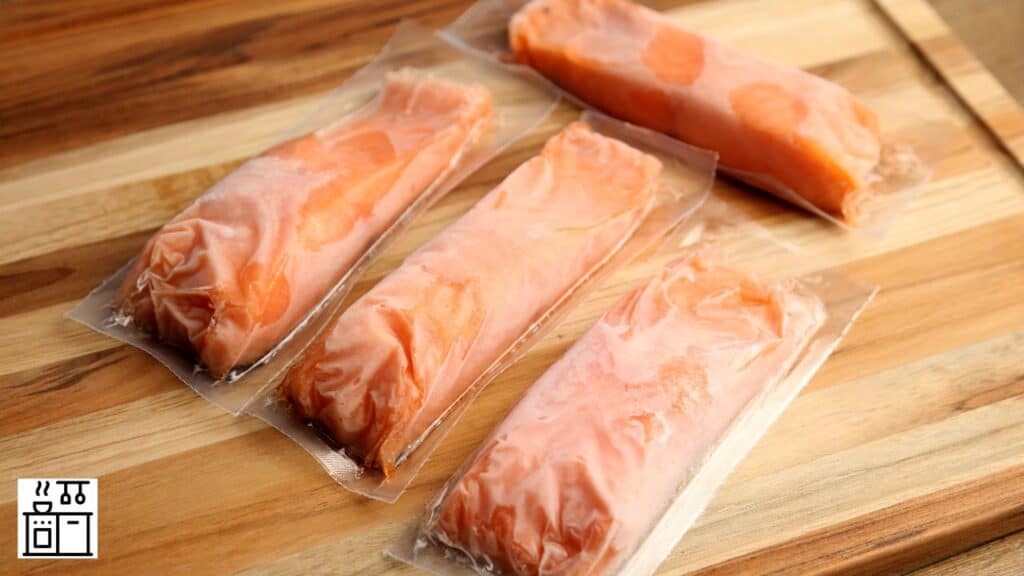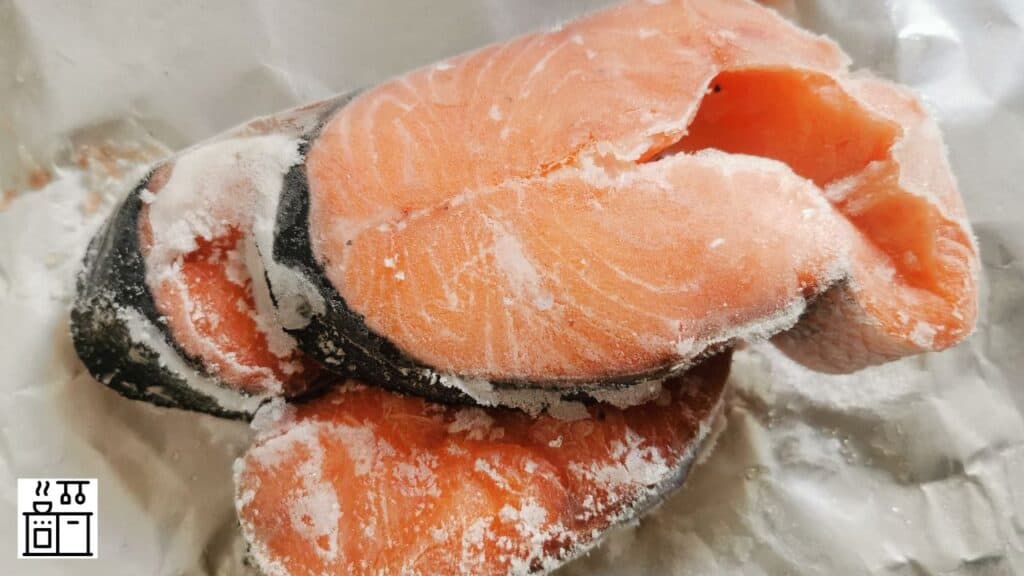All of us make the mistake of forgetting to thaw fish, like salmon, ahead of time.
It can be terribly disappointing to realize this just when it’s time to cook it.
Fortunately, salmon is an ingredient that you can cook from frozen. So, can you pan-fry frozen salmon?
Pan-Frying Frozen Salmon
Pan-frying isn’t the best way to cook frozen salmon. Nevertheless, you can pan-fry frozen salmon after rinsing it to get rid of the ice and drying it well. You will have to wait until it’s partially cooked to season it, which can affect the final flavor. You should also be careful to cook it with the skin against the pan to prevent it from becoming soggy due to excess moisture.
While it’s not highly recommended to pan-fry frozen salmon, there are various other methods to cook frozen salmon to perfection.
Let’s look at some of them.
6 Best Ways to Cook Frozen Salmon
Cooking salmon from frozen is convenient when you forget to thaw it ahead of time or need a quick meal.
Salmon isn’t thick or tough like other cuts of meat.
Hence, it doesn’t present too many challenges, even if you are working with frozen salmon.
Here are some of the different ways to cook frozen salmon.
1. Poaching Salmon
Poaching is one of the best options for cooking frozen salmon because you can skip the thawing process altogether.
The only difference when working with frozen fish during poaching is that you must add a few extra minutes.
To poach frozen salmon, place the fish in a shallow saucepan or skillet.
Fill the pan with enough water to completely submerge the fish.
Alternatively, you can also immerse it in other types of liquids, like vegetable or fish broth.
Place the pan with the fish on gentle heat and let it simmer for ten to twelve minutes.
Your salmon may require more or less time to cook, depending on its size.
Once cooked, take it out of the liquid and serve hot.
2. Bake Salmon from Frozen
Another way to cook salmon from frozen is to bake it in the oven. Preheat the oven to 450°F.
Meanwhile, rinse the salmon fillets under water to get rid of the ice on their surface.
Gently pat them dry with a paper towel to remove the excess moisture before proceeding to the next step.
You can lightly brush the surface of the salmon with oil and season it with a little salt and pepper.
Most of the oil and seasoning will not infuse into the flesh since the fish is frozen.
So you will have to season it again mid-way through the baking process.
Place the salmon in the oven and bake for eight minutes.
Then, take it out, season it again, and return it to the oven.
It will take eight to ten more minutes to cook completely.
You will know when it’s done by inserting a knife between the layers. The salmon should be opaque throughout.
3. Pan Frying Salmon from Frozen
The main factor that makes pan-fried fish attractive is the crispy skin and soft, tender flesh.
It’s difficult to achieve this texture when working with frozen salmon.
Nonetheless, you can enjoy good results if you tweak your frying process a little.
Start by rinsing the salmon under water and drying it to remove any excess moisture from the surface.
Heat oil in a skillet over medium heat and place the salmon skin-side up in the skillet.
Cook it for about four minutes before flipping it.
Season the salmon at this stage with salt and pepper.
You can add any other seasoning ingredients as well if you prefer.
Turn the salmon over and cover the skillet with a lid to cook thoroughly.
The salmon should be skin-side down, so it crisps up well.
If the skin isn’t in contact with the pan, it will become soggy and unappealing.
When fully cooked, it will be soft and flaky on the inside.
4. Cook Frozen Salmon in The Microwave

You can cook frozen salmon in the microwave.
For this, start by gently brushing the salmon with a bit of oil on the surface.
Seasonings will not usually infuse into the skin since it’s frozen, so you can skip that step.
Wrap the salmon in baking paper or cling film and place it in a microwave-safe dish.
Then cook it for three minutes.
The salmon will have turned soft by then.
Remove it from the microwave and season with salt, pepper, and any other herbs of your choice.
Wrap the fish again and return it to the oven.
Cook it for five more minutes. It may need longer if you are working with a large cut.
Let the fish stand for half a minute before taking it out. Remove the wrapping paper and serve it while it’s still hot.
5. Grill Frozen Salmon
Frozen salmon will stick to the grill grates when you place it directly.
It will be a pain to clean it, and most of the fish will also end up being inedible.
To overcome this problem, we suggest wrapping the fish in leaves like plantain leaves or grape leaves to grill them.
To grill frozen salmon, start by preheating the grill. Wash and dry the salmon fillets to get rid of excess moisture.
Then, brush the surface with oil and add the seasoning of your choice.
Next, wrap each salmon fillet in a leaf and use another leaf to wrap over it.
If the leaves are small, you may like to line them up so that they overlap, and you can roll up the fish in a pair of leaves.
Place the wrapped salmon on the hot grill and wait for it to develop charred spots before turning it over.
It will need five to six minutes on each side to cook thoroughly since the fish is frozen.
Check whether the flesh has turned opaque throughout to take it off the grill and enjoy.
Related Further Reading:
6. Sous Vide Salmon
Sous vide is an interesting cooking technique where the ingredients are vacuum sealed in an airtight bag with herbs and boiled in a water bath.
It’s a slow cooking technique that uses gentle and controlled heat to cook the ingredients.
You will need special sous vide equipment for this technique.
However, it’s one of the best ways to cook frozen salmon because salmon is an oily fish.
It cooks beautifully when exposed to gentle heat, and the slow process brings out its natural flavors.
It’s also not easy to overcook, making it the perfect candidate for this method.
To sous vide salmon, gather all the ingredients.
Apart from salmon, salt, and pepper, you can add seasonings like dill, garlic, oregano, or herbs.
You can also use lemon juice, butter, or a dash of olive oil for extra flavor.
Set up the sous vide by filling a pot with water and heating it to a temperature of 125°F.
While the water boils, season the salmon.
Then, place the salmon fillet inside the sous vide bag and add the herbs and oil or butter into it.
Seal the bag after removing air from it using a vacuum sealer.
Place the salmon in the water bath and cook it for about fifty minutes.
Frozen salmon will take more time than thawed salmon to cook thoroughly.
To finish the salmon, transfer the fillets from the bag into a skillet with butter or oil. Cook for a few minutes.
You can flip it over and add lemon juice if you prefer.
Finally, baste the salmon with melted butter and let it cook for a minute before serving it.

